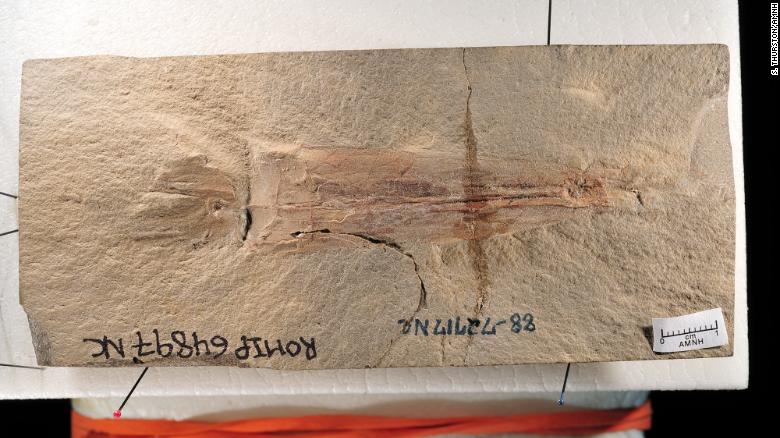Look at the strange blanket octopus that you only see "once in a lifetime" 1:06
(CNN) --
The oldest ancestor of modern octopuses lived 328 million years ago and had 10 arms, according to a new study.
Researchers have named this hitherto unknown species
Syllipsimopodi bideni
, after US President Joe Biden.
The discovery of the creature changes the beginning of the appearance of vampires, a group to which cephalopods such as octopuses belong, in almost 82 million years.
The study was published Tuesday in the academic journal
Nature Communications.
Vampiropods are known to have eight legs, an inner shell made of chitin, and a soft body, the latter of which does not appear often in the fossil record because it tends to deteriorate faster than hard structures like bone.
A well-preserved fossil was discovered in Montana's Bear Gulch limestone formation and donated to Canada's Royal Ontario Museum in 1988. The specimen represents the oldest known ancient relative of these creatures, a new analysis of the fossil has revealed.
This artist's illustration shows a 328-million-year-old ancestor of modern octopuses and vampire squids.
"This is the first and only known vampire to possess 10 functional limbs," study author Christopher Whalen, a postdoctoral researcher in the Division of Paleontology at the American Museum of Natural History, said in a statement.
advertising
The exceptionally well-preserved vampire fossil is in the Royal Ontario Museum in Canada.
"All previously reported vampiropod fossils with preserved limbs only have eight arms, so this is possibly the first confirmation of the idea that all cephalopods ancestrally possessed ten arms."
Syllipsimopodi is the fossil best known for understanding how vampires arose, as well as helping researchers trace their evolution, said Whalen, who is also a National Science Foundation postdoctoral fellow in the Department of Earth and Planetary Sciences at Yale University.
Researchers have previously worked on the theory that vampires started out with 10 arms and ended up losing two of them over time, and now they have direct evidence.
tiny but mighty
The detailed fossil clearly shows a creature about 12 centimeters long with 10 arms, with the suckers still attached - an incredibly rare find as these arms were essentially just muscle.
Two of those arms appear to be longer than the other eight, and its body was shaped like a torpedo, similar to that of the modern squid.
Investigators also found remnants of his ink sac.
Soft-bodied cephalopods are divided into vampires and decabrachians.
Among the vampires are the octopuses and the vampire squids, which differ from the current squids.
Vampire squids basically look like octopuses with a parachute attached, as they have a membrane that stretches between their arms and connects them.
They also have two structures that help them feed, called filaments, in addition to their eight arms.
For their part, decabrachia include modern squid and cuttlefish, which have 10 arms, including two tentacles.
There are a number of differences that separate cephalopods like squids and octopuses, but the number of arms is one of the most recognizable.
So why is this fossil considered to be a vampire, even though it has 10 arms?
The team's phylogenetic analysis, indicating evolutionary relationships, placed the species on the vampiropod evolutionary tree, Whalen said.
The new species also had several key anatomical traits that mark it as a vampire, including the loss of a cephalopod shell used to regulate buoyancy, called a phragmocone, seen in extant creatures like nautiluses.
"The age makes the fossil very significant: it indicates that vampires (and by extension decabrachians) are much older than previously thought (at least 82 million years)," Whalen said.
"It indicates that there is a long time interval during which fossil vampires must have existed but have not yet been found."
Stunning glass octopus caught on video 0:52
What's in a name
Syllipsimopodi probably used its
longer
pair of arms to capture prey and the rest of its shorter arms to grab small creatures out of their shells.
It also had flippers, which probably helped it maintain stability and help it swim.
"
Syllipsimopodi
may have occupied a niche more similar to living squid, a mid-level aquatic predator," study co-author Neil Landman, curator emeritus in the Division of Paleontology at the American Museum of Natural History, said in an email. release.
The team was surprised to discover that
Syllipsimopodi
had a gladius, or plume, the tongue-shaped, semi-transparent part of the inner shell of cephalopods.
"The gladius functions to provide structural support, as a rigid structure that muscles can pull against, and as an anchor for fins (overall function similar to our bones)," Whalen wrote in an email.
"The gladius is considered a fairly advanced feature in the grand scheme of cephalopod evolution. Currently, only squids and their relatives, and the vampire squid, have a gladius. The octopods have reduced it to either a fin support or the stylets, which are small, hard, rod-shaped structures.
The creature's genus name,
Syllipsimopodi
, is a nod to the Greek word "syllípsimos", meaning "prehensile", and "pódi" for foot, because it is the oldest cephalopod yet discovered to have suckers on its arms.
And the species name, bideni, is in honor of Biden, who had just been inaugurated when the study was submitted for publication.
"I was encouraged by the plans that President Biden laid out to counter anthropogenic climate change, and his general feeling that politicians should listen to scientists," Whalen said.
FossilsOctopus












